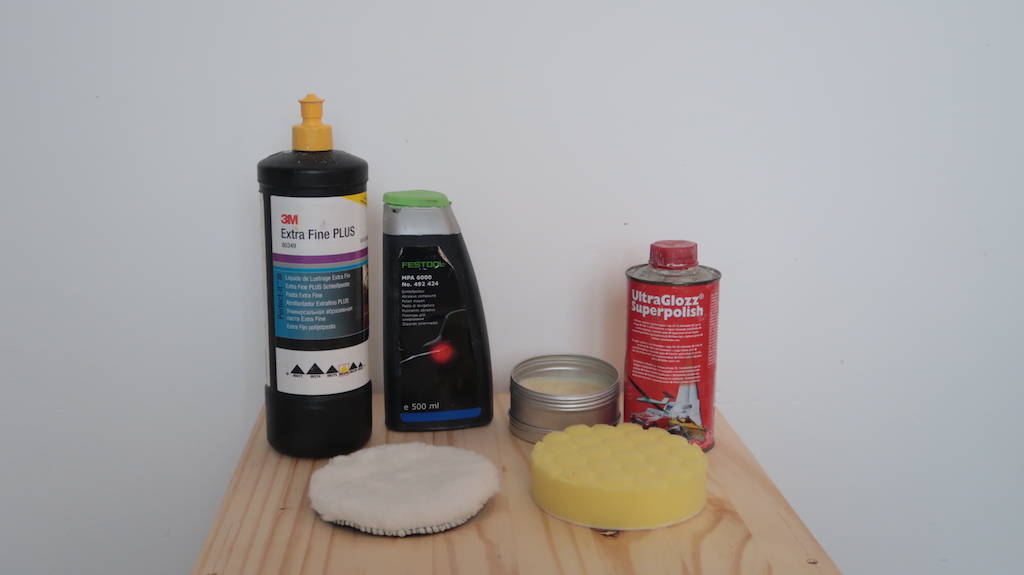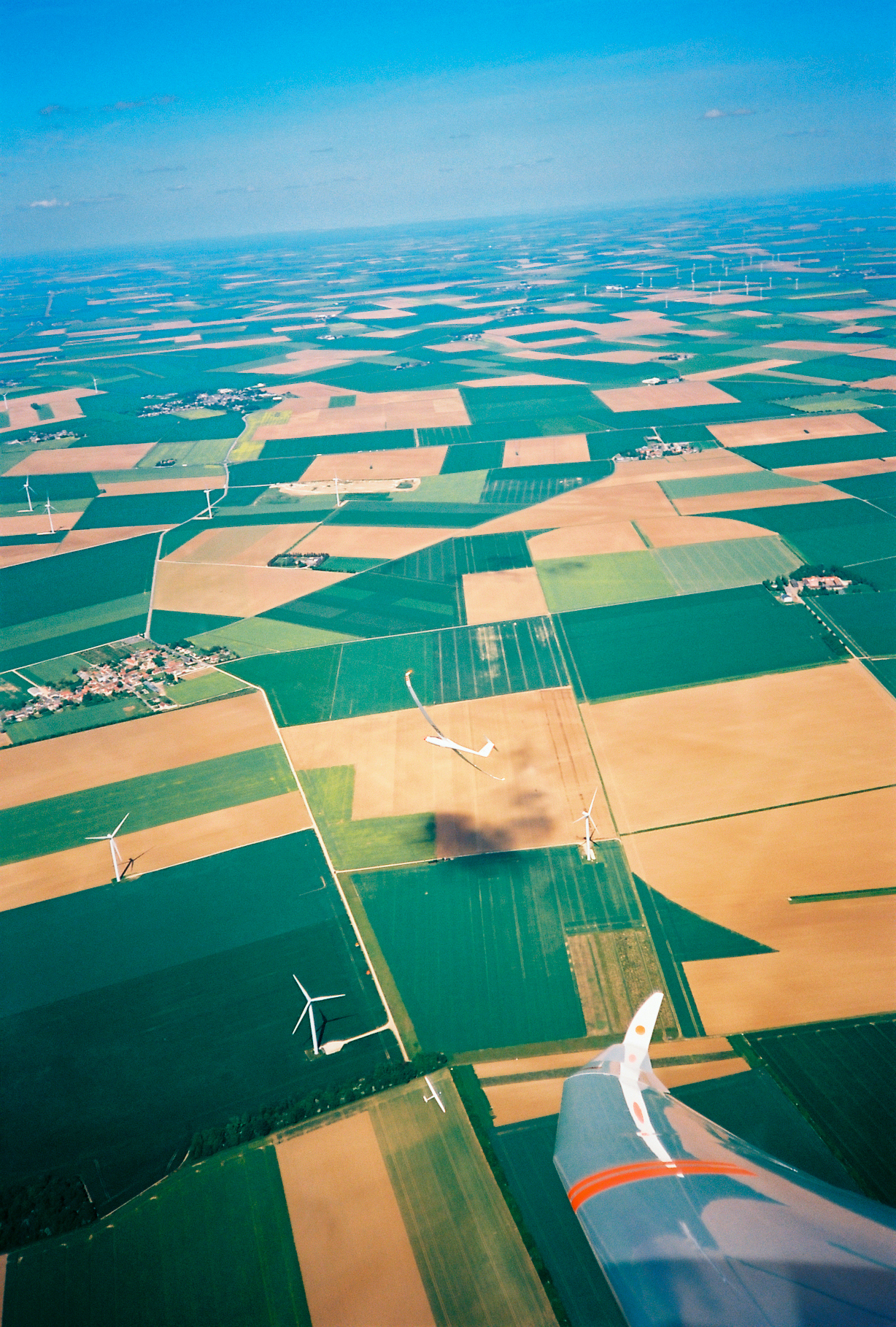Proper Polish and Wax
Home
Youtube-Channel
About
Shop
To keep your glider in top shape it’s important to polish and wax the glider on a regular basis, we all know this. The difficulty is that very few seams to know how to do it properly, me included before reading up on the subject the last year. After dealing with gliders for almost 20 years I still have missed vital steps to achieve a good result.
Ok, let’s go thru it.

fine/corse polish, DIY paste wax and sealant, wool pad and foam pad
General Approache
Gelcoat: Once per year polish and 2-3 times per year wax.
PU/2K/Car paint: Polish gently when needed (not every winter!) and wax 2-3 per year.
Both gelcoat and PU/2K/Car paint accumulate scratches from normal usage and these are removed when polishing. Gelcoat also oxides which is why we need to polish it more frequent on a regular basis.
PU/2K/Car paint is around 0.2mm thick. Gelcoat is around 1-2mm thick. When working on PU/2K/car paint we need to use much finer grit sandpaper and polish!
After flying, don't clean your glider with just water! Use something that will add wax to the surface, otherwise you are slowly removing all the protection(wax/sealant). You can use water if you add wax/sealant directly after.
Products To Use
Wax
Let’s start with wax or sealants, they do the same thing, protect the surface from UV sunlight and contamination. Ceramic coatings also falls in the category of sealants.
Wax is a natural material harvested from mainly bees wax or from Carnauba (a palm tree in Brazil). The wax in its natural form is what we want to protect our surface, but it’s much too difficult to work with since it’s rock hard. The wax you buy is basically a mix of the wax and some kind of solvent to make it easier to spread and work with.
Sealant is a laboratory made substance that do the same thing as wax. They usually last a bit longer than wax and sometimes are easier to work with.
You can put wax on top of sealant but not sealant on top of wax! It will just quickly disappear.
It's a good idea to first put a layer of sealant on the surface and then a wax layer. By doing this you can wash the bugs off the glider using wax during the season without worries of removing all UV protection, since there is a sealant layer which will not be dissolved by the wax.
Polish
Polish is basically a liquid sand paper. When working on gel coat you can use a coarse(green top bottle in the picture) and a fine one(yellow top bottle in the picture). For PU/2k/Car paint just use the fine polish.
Regarding both Polish and Wax: Choose silicone free! For gelcoat, use products that are made for it (generally boat products). For PU/2K/Car paint, use car products.
How-To
In the following steps
1.
First start with a proper clean of the wing, this can be done with warm water and a sponge. Make sure the sponge/buckets/microfibre towels you use is properly clean before using them on the glider. It's good to start your work by cleaning them.
If you intend to polish you need to clean away the old wax, this is important. To clean away old wax you can use hand dishwashing liquid in a strong mix with water. If you don’t clean away the old wax it will fill up your polishing pad and drastically reduce the polish result.
2.
Start by polishing with a machine at low RPM. For gelcoat use a wool pad (this have a large ‘cut’ suitable to remove oxidation) and for PU/2K/Car paint use a foam pad. You will need at least two which you can swap between.
Only polish around 1/2 square meter at time. Polish is an abrasive and the pad will be filled up by residue(very fast on gelcoat!), thus after around 1/2 square meter it needs to be cleaned. (when wet sanding, the water take away the residue. When dry sanding, it flies away in the air). To clean the pad, wash it in water and dry it on the machine by spinning it quickly. Change pad to your second and let the first dry until next change.
When polishing, the surface needs to always be moist! If it goes dry, add more polish liquid or spray a mist of water on the surface. If it goes kind of solid, like a paste, you have much too much residue in the pad. Replace the pad, properly clean the surface with water and add new polish liquid.
3.
When you're done with your surface, clean it properly as good as you can to remove all residue from the polishing. Use water and a wet microfibre towel. Make sure the surface is wet(if it's dry it might scratch) and wipe with very light pressure.
4.
Apply sealant and/or wax when the surface is dry. Applying too much will just be a waste of sealant/wax but applying too little will not give you the correct protection you want. Thus, be generous when applying. I prefer to do this by hand with a clean rag to get the best cover and result. Wait for the wax to dry(this is very important for sealants! Check the bottle), 20min is usually good, before wiping off. If you use both, remember to use sealant first and then wax as final layer
DIY-Wax
When reading up on the subject it became clear that: The harder the wax, the more long lasting with better protection. And creating your own wax to suit the application is not hard at all. These will be harder to work with but they are completely free from any solvents and chemicals, so they are more friendly to your skin to work with. After a bit of experimenting I came up with two recipes: one for hard wax and one for paste wax.
Hard Wax
Carnauba wax. 20 gram
Bees wax. 4 gram
Coconut oil. 35 gram
Paste Wax
Carnauba wax. 20 gram
Bees wax. 4 gram
Coconut oil. 70 gram
Melt the ingredients in a dubble boiler and pour in to a suitable mould or container. Just increase the amount of ingredients linear to make a bigger batch.
Happy Flying!

Support me
I build and maintain this site to help you. I do it in my spare time and it's not free.
I DON'T WANT ADVERTISEMENT on this site. Help me to help you:
Buy me a beer!
© 2019 Niklas Löfgren
|